|
It
is probable that only in Hollywood - and then, only in the early '70s
- could a word like blaxploitation be coined. The root and meaning
of the word is obvious; for some time, cheap action flicks featuring
the underused minority actor community were the flavor of the month
in theaters. The problem, of course, was the ploitation part.
Most often, these flicks were simply recast versions of earlier, all-white
movies, made quickly and efficiently and hurled into distribution. In
an effort to distinguish themselves from the other Shaft and
Black Caesar clones, some filmmakers started striking out into
other filmic territory. After awhile, things got a little absurd,
as in Blackenstein
(shudder); and some that were at least halfway original in concept,
like Sugar Hill.
We
start off promisingly enough with your typical voodoo ceremony, complete
with snakes, chicken blood, and convulsing dancers possessed by loa.
The opening credits run over this scene, and it is scored by the song
"Supernatural Voodoo Woman" by The Originals (courtesy Motown
Records), which, while listenable, is a bit too slow for the antics
onscreen - our first indication that something is up. The second indication
is when the ceremony is over, lights come up and applause thunders;
we have been watching the floor show at the incredibly successful Club
Haiti.
In
attendance is Diana "Sugar" Hill (Marki Bey), the fiancee
of the Club's owner, Langston (Larry B. Johnson). A short round of loverly
billing and cooing is interrupted by the arrival of four thug-types,
led by Fabulous (Charles Robinson), who will be modeling all the retina-scorching
Huggy Bear pimp clothes for this outing (although Langston's jacket
with the odd scalloped lapels bears mentioning). Fabulous comes bearing
news (okay, a veiled threat) from Morgan, a local crime lord who wants
to buy Club Haiti. Langston, of course, refuses, and in a remarkably
lame fight scene, gets beaten to death in the parking lot for his defiance.
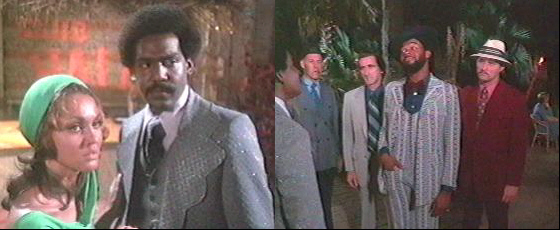
Since
the attackers all wore stockings over their heads (though who could
not have recognized Fabulous' attire?) the police can do nothing, so
Sugar returns to her run-down ancestral mansion, where (for some reason)
the local ancient voodoo queen Mama Maitresse (Zara Cully) is living.
Sugar begs Mama Maitresse to use her voodoo powers to grant her vengeance
on Morgan and his gang, so Mama takes Sugar waaaaaay into the swamp
in back to her voodoo altar, that they may conjure up the Lord of the
Undead, Baron Samedi.
Now,
it was during the lengthy journey into the swamplands that I found myself
thinking, "I could have started the movie here and still
recognized it as an American International picture." Then I tried
to figure out why I would have thought such a thing. Best I could
come up with was that, although we are supposedly in the swamplands
of Louisiana, the sound effects are exactly the same as those used in
1950's jungle movies, complete with that tell-tale bird that goes oo-oo-oo-oo-oo-oo-ah-ah-ah-ah-ah-OO!
OO! I kept expecting to hear an elephant trumpet.
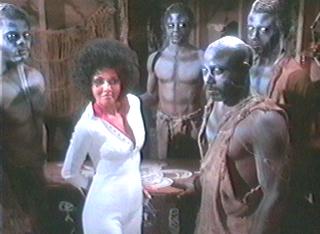 In
any case, Baron Samedi arrives (in broad daylight; I still don't know
if that was brilliant or a mistake) and Sugar petitions him for his
aid. "And what will you give me?" asks the loa. "My
soul!" Sugar answers without hesitation. "Ha! It's not your
soul I want," Samedi replies. "The Baron is quite a
lover," explains Mama Maitresse. To bear this out, the Baron is
immediately flanked by a pair of zombie babes. Impressed by Sugar's
lack of fear in his presence, Samedi agrees to help, causing a number
of slaves buried in the swamp during a fever epidemic a century before
to rise up, still shackled and carrying machetes. "Put them to
evil use!" bellows the Baron. "It is all they know or want!" In
any case, Baron Samedi arrives (in broad daylight; I still don't know
if that was brilliant or a mistake) and Sugar petitions him for his
aid. "And what will you give me?" asks the loa. "My
soul!" Sugar answers without hesitation. "Ha! It's not your
soul I want," Samedi replies. "The Baron is quite a
lover," explains Mama Maitresse. To bear this out, the Baron is
immediately flanked by a pair of zombie babes. Impressed by Sugar's
lack of fear in his presence, Samedi agrees to help, causing a number
of slaves buried in the swamp during a fever epidemic a century before
to rise up, still shackled and carrying machetes. "Put them to
evil use!" bellows the Baron. "It is all they know or want!"
Sugar
wastes no time in tracking down and giving Langston's killers their
comeuppance. One winds up on the wrong end of the zombie's machetes
in a dockside warehouse - a positive ID is only possible when the police
find his head in what appears 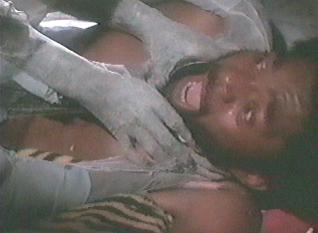 to
be a bag of grits. Another is tossed into a pen full of hungry pigs
(Sugar: "I hope they're into white trash.") Yet another
is forced via voodoo to stab himself to death. And Fabulous, visiting
his favorite massage parlor, finds himself locked in a room full of
zombie ho's. to
be a bag of grits. Another is tossed into a pen full of hungry pigs
(Sugar: "I hope they're into white trash.") Yet another
is forced via voodoo to stab himself to death. And Fabulous, visiting
his favorite massage parlor, finds himself locked in a room full of
zombie ho's.
Complicating
matters on Sugar's vengeance trail is her old beau Valentine (Richard
Lawson ), a police detective who starts to suspect that voodoo is at
the root of this one-sided gang war, and that Sugar is somehow involved;
also concurrent is the Big Boss Morgan's (Robert Quarry) continued attempts
to obtain Club Haiti from Sugar by dint of his questionable suaveness...
this to the dismay of his equally racist cracker moll Celeste (Betty
Anne Rees). This leads to the mandatory catfight between Sugar and Celeste,
which is every bit as lame as the earlier fight scene (you would think
there is no way to screw up a catfight, but a way was found).
So
let's get back to the zombie mayhem. After one hit man looking for answers
winds up nailed to the wall with machetes, the very last member of Morgan's
gang is locked into a coffin loaded with snakes. A thoroughly pissed-off
Morgan tries to hunt down Sugar in her mansion, but finds instead a
room filled with all his dead henchmen, now quite undead and
ready to off him. The horrified Morgan is smashed through a window
by a Spring Loaded Cat™. There's a bit of a chase, out into Maitresse's
swampy church, where Morgan meets the end determined for all bad guys
who run into a swamp, i.e., a convenient pit of quicksand.
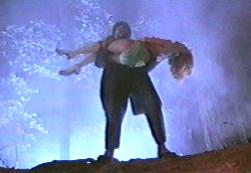 To
keep her part of the bargain with Samedi, Sugar gives him Celeste. The
Baron acknowledges that he would much prefer Sugar herself, but a deal
is a deal, and he carries the unwilling, go-go booted moll into a nearby
smoky special effect. The end... to the tune of "Supernatural Voodoo
Woman", natch. To
keep her part of the bargain with Samedi, Sugar gives him Celeste. The
Baron acknowledges that he would much prefer Sugar herself, but a deal
is a deal, and he carries the unwilling, go-go booted moll into a nearby
smoky special effect. The end... to the tune of "Supernatural Voodoo
Woman", natch.
As
one can tell from the summary, the plot is strictly first-year revenge
drama stuff - it is the addition of voodoo and the resurrected slaves
that causes one to hope that this movie might actually carve out its
own identity, possibly bring some illumination to the blackness
of the experience, not merely using it as a backdrop for a cheap horror
film. There is only one thing that keeps Sugar Hill from fulfilling
that promise: the script itself, which is shabby beyond redemption.
The first scene between Sugar and Langston is mildly painful, leading
into the stand-off between Langston and the thugs, which was scripted
by constantly pulling down the lever on the Cliché-o-matic®
and appending the epithet "boy" to the end of every other
line.
Once
the zombie plot kicks in, at least, our attention is distracted from
the trashbin dialogue. The actors struggle mightily with their lines,
and manage to overcome this burden for the most part; practically every
speaking role is competently acted. Several of the henchmen/zombie victims
are truly unfortunate exceptions. Then, they are only called upon to
confirm they are racist cretins, snivel a bit, and then die.
Do
you remember when Robert Quarry was apparently being groomed as a new
horror star? Whatever happened to that? Sugar Hill was reportedly
Quarry's last film under his AIP contract, and he doesn't look like
he's enjoying it. Sporting a southern accent worthy of Joseph Cotten,
Morgan makes us wonder just exactly what a Big Crime Lord does all day.
From all 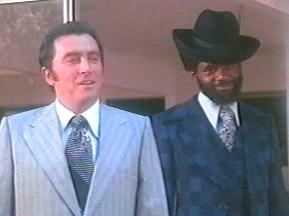 appearances,
he lounges around his apartment, drinking and abusing his underlings,
especially his moll and Fabulous. appearances,
he lounges around his apartment, drinking and abusing his underlings,
especially his moll and Fabulous.
Which
leads us to another criminally undeveloped subplot. After Langston's
beating death, the first scene with all of the gang meeting in Morgan's
apartment finds Fabulous, the sole black member of the gang, shining
Morgan's shoes. Morgan urges him to work on the (symbolically?) white
patent leather some more, claiming that "We'll make an honest nigra
of you yet." We have the possibility of some real dramatic tension
here, a sort of reverse Othello situation. Why does Fabulous
put up with this? What is he getting from this relationship? Is it part
of some elaborate scheme on his part? We'll never know, because Fabulous
smiles and goes back to work on the shoes.
So,
really, thank the God of Bad Movies for those zombies. Though they are
remarkably intact for having spent a century in the ground, they are
nonetheless some of the creepiest shamblers to grace the screen. It's
not merely the cobwebs, graveyard dirt and shiny bug-eyes that grace
each zombie, no, it's the fact that these undead like to smile.
A lot. If evil truly is "all they know, or want," well,
these fellas really enjoy their work. Those grins are unnerving
in the extreme.
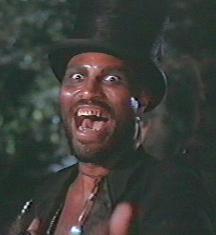 As
Baron Samedi, Don Pedro Colley simply folds up the film neatly and tucks
it under his arm. Colley did actual research into voodoo beliefs and
crafted a Lord of the Undead who is perversely full of life, whose manic
grin is echoed in that of his minions. When I first saw Sugar Hill years ago, it was Colley who impressed me and continued to be memorable,
long after every other detail of the movie had faded away. Samedi maintains
a presence throughout the picture, appearing as a bartender, a cab driver,
and even a slow-witted groundskeeper who isn't so slow that he can't
introduce himself as "Old Sam"; this goes so far as to confirm
the Baron's lesser-known function as a trickster spirit. As
Baron Samedi, Don Pedro Colley simply folds up the film neatly and tucks
it under his arm. Colley did actual research into voodoo beliefs and
crafted a Lord of the Undead who is perversely full of life, whose manic
grin is echoed in that of his minions. When I first saw Sugar Hill years ago, it was Colley who impressed me and continued to be memorable,
long after every other detail of the movie had faded away. Samedi maintains
a presence throughout the picture, appearing as a bartender, a cab driver,
and even a slow-witted groundskeeper who isn't so slow that he can't
introduce himself as "Old Sam"; this goes so far as to confirm
the Baron's lesser-known function as a trickster spirit.
I've
gone almost the entire review without talking about the leading lady,
the title character, haven't I? Marki Bey is a bit problematic - I get
the impression she was being offered up as the next Pam Grier, but that
was a crowded field at the time and Bey didn't quite measure up. It's
not that she's a bad actress. She holds up quite well against the heinous
scripting, but she is victimized by one of the strangest motifs I've
yet seen in a film.
You
see, it's her hair. In the common, day-to-day scenes, Bey's hair is
processed, flat, dark red. But put her around some zombies and she's
suddenly sporting a Jim Kelly afro (and dazzling white jumpsuit). Punching
the timeclock, she's Jackie Brown; punching some villain's timecard,
she turns into Get Christy Love.
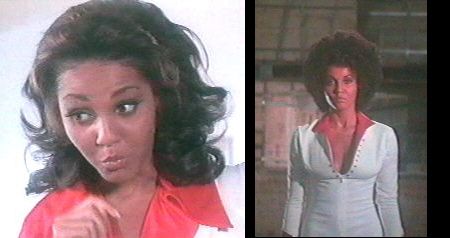
I
have tried to reconcile this. Zombie scenes shot later? Earlier?
None of that works logistically, not in a speedily shot AIP flick. The
only interpretation I can offer is that the straight, processed
look represents Sugar as she attempts to carve out her piece of the
white man's world; but in her dealings with Mama Maitresse and Baron
Samedi, she gets back in touch with her 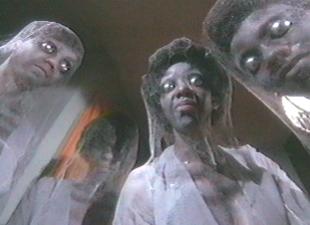 own
true ethnicity, and with it, power. Thus, she morphs into a Soul
Train dancer. This is a shallow interpretation, I know, but movies
like Sugar Hill don't exactly have a deep end. own
true ethnicity, and with it, power. Thus, she morphs into a Soul
Train dancer. This is a shallow interpretation, I know, but movies
like Sugar Hill don't exactly have a deep end.
You
have to approach Sugar Hill with a bit of tolerance and good
humor for the horribly dated parts (as when Morgan, completely out of
character, opines that Sugar is "a very foxy lady"), the bad
dialogue cut-and-pasted from other bad movies, and the near constant
reminders that the bad guys are offensive, racist jerks (I get it, I
get it, kill 'im already!). Don't expect Italian attack zombies. Do
expect some creepy nightwalkers, camerawork, and acting better than
the script deserves, and you and Sugar Hill will part friends
over that last encore of "Supernatural Voodoo Woman".
|